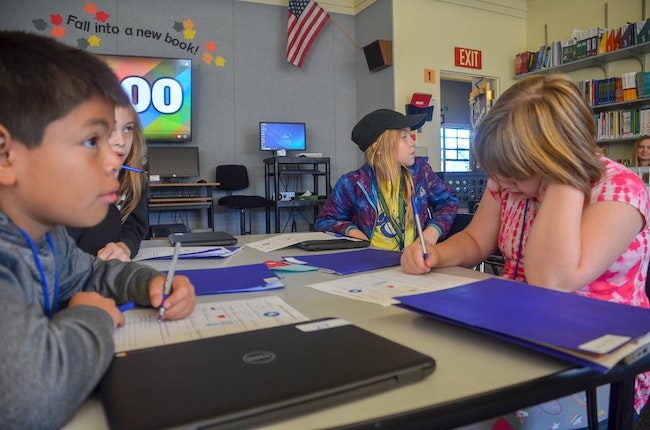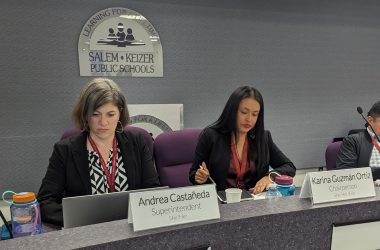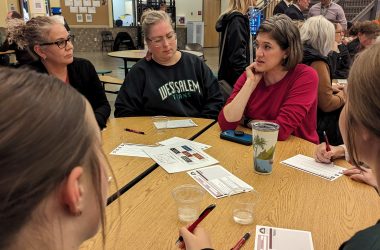 Jared Vergara Santana, left, Evelyn Francis, right, Iris Johnson, right back and Lillyana Green, back left, write during class at Hoover Elementary School. (Rachel Alexander/Salem Reporter)
Jared Vergara Santana, left, Evelyn Francis, right, Iris Johnson, right back and Lillyana Green, back left, write during class at Hoover Elementary School. (Rachel Alexander/Salem Reporter)
Want a say in how $35 million is spent in local schools?
Salem-Keizer School District leaders are looking to hear from citizens about how best to spend extra state money that could benefit nearly every child in the district.
The money is Salem-Keizer’s portion of the $2 billion education package Oregon legislators passed in the spring, aimed at improving student performance and addressing behavior and social needs.
It’s a broad mandate, and educators have freedom to decide how to best spend funds. Superintendent Christy Perry wants to focus on improving success rates for black, Pacific Islander and Native American students, students from low-income families, students with disabilities and those who are homeless or in foster care.
[ Help build Salem Reporter and local news – SUBSCRIBE ]
The public can weigh in at two community meetings:
Monday, Nov. 18, at McNary High School from 6-8 p.m.
Wednesday, Nov. 20, at South Salem High School from 6-8 p.m.
Both meetings will have free childcare, free dinner and translation and interpretation in Spanish.
Perry has already spoken to community groups about the money, and put together a task force of about 40 district employees and citizens who met weekly in October to dig through data and identify challenges.
Task force members will lead both meetings and plan to ask parents what’s worked well for their children at school, what’s been hard for them and what they think the district could do more of.
At a final meeting last week, members of the task force shared specific things they think Salem-Keizer could do better for each group of students that leaders want to improve outcomes for.
“We may enhance those things, we may take away from those things, we may add new things,” said Reginald Richardson, co-leader of that task force who by day is executive director of Oregon Alcohol and Drug Policy Commission.
Staff training, better tracking of students and more support for things like homeless students who need to finish homework at school were common themes in the discussion.
Jay Mundo, a Pacific Islander parent and district employee, said school employees often take a one-size-fits all approach to Islanders, not accounting for cultural differences between widely-spaced islands. He’s from the Northern Mariana Islands, where English is taught from an early age and American-style schooling is emphasized.
Other islanders may not learn English until they come to the U.S.
“Pacific Islander is a vast cultural demographic,” he said. “Does the staff know the history and the government?
Some task force members suggested home visits or other ways to engage parents who might not feel comfortable meeting with a principal or teacher at school.
Task force members and district leaders will also plan smaller meetings to talk to parents and others from the demographic groups they want to serve.
Task force members will deliver recommendations to Perry in January. The district must present final plan to the state in March.
Perry has begun talking about the money with local business and education leaders, and working to temper expectations. At an Oct. 23 meeting, she cautioned several dozen Salem-area leaders that $35 million wouldn’t solve every problem facing the school system.
“Even with the Student Success Act, it won’t be enough,” she said.
She also asked for their help reaching out to the community and keeping discussion focused on the student groups that the district wants to help.
“Anytime you have money, you have people lining up,” she said. “It’s going to be hard to keep those priorities amid political pressure.”
Reporter Rachel Alexander: [email protected] or 503-575-1241.

Rachel Alexander is Salem Reporter’s managing editor. She joined Salem Reporter when it was founded in 2018 and covers city news, education, nonprofits and a little bit of everything else. She’s been a journalist in Oregon and Washington for a decade. Outside of work, she’s a skater and board member with Salem’s Cherry City Roller Derby and can often be found with her nose buried in a book.









